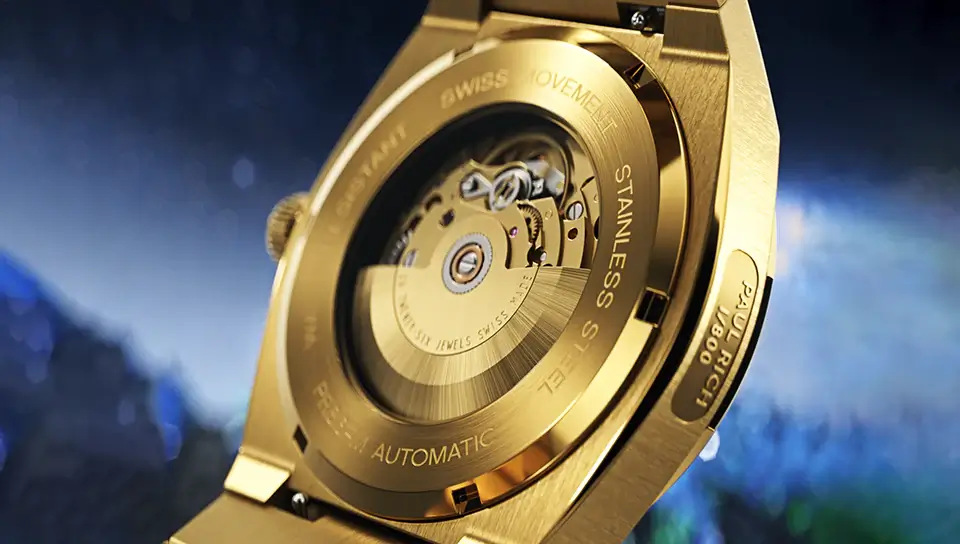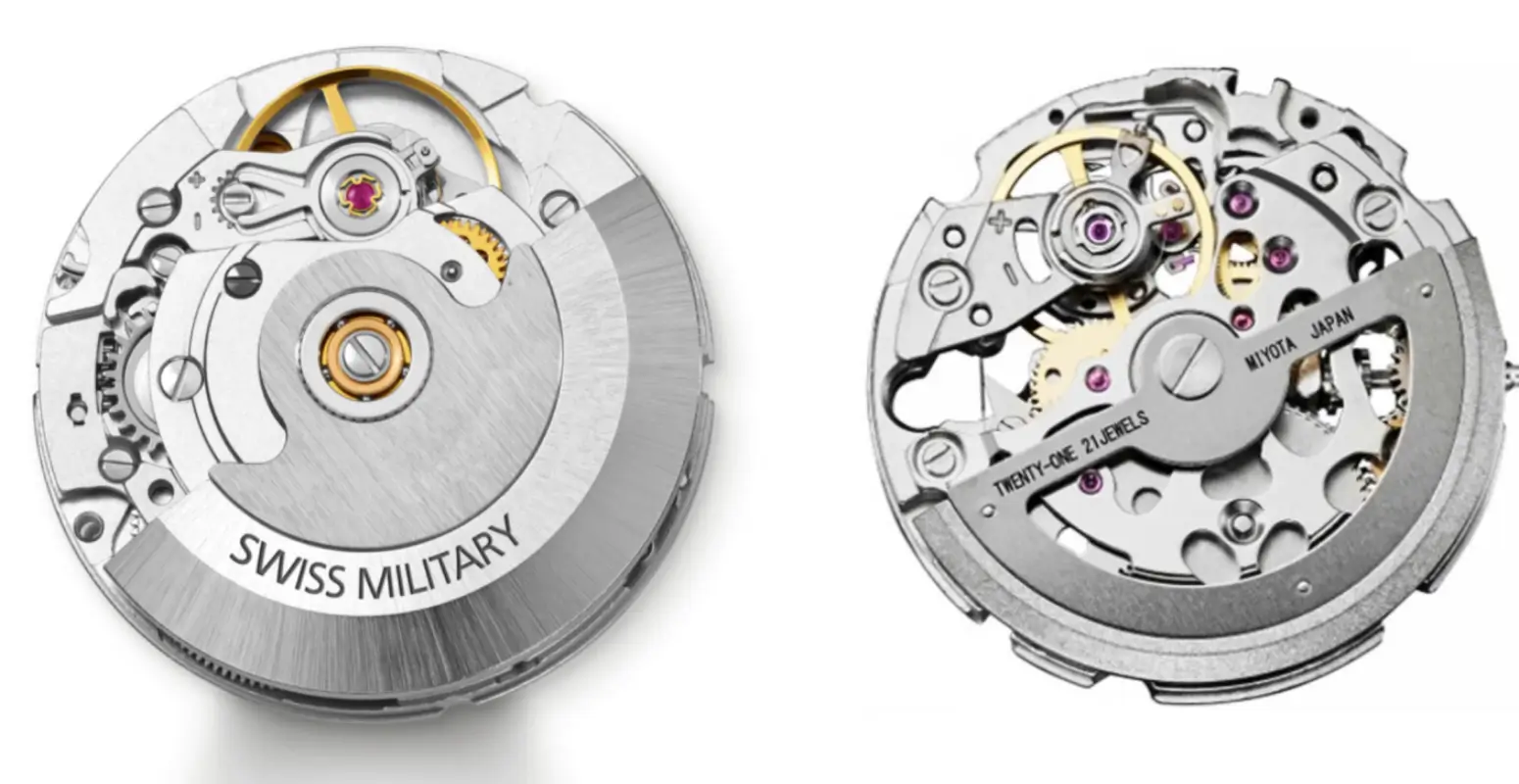Swiss vs Japanese Quartz Watch Movement: A Complete Comparison Guide
Watch Guides
2025-06-30Introduction
When choosing a quartz watch, one of the most common dilemmas watch enthusiasts and collectors face is: Swiss vs Japanese watch movement—which is better? From luxury timepieces to affordable everyday watches, both Swiss quartz movement and Japanese quartz watch movements dominate the global market.
This in-depth guide breaks down the key differences between these two iconic movement types. If you're a seasoned collector looking for the most accurate quartz movement, or simply curious about what distinguishes a 'Swiss movement watch' from a 'Japan movement watch,' this article will help you make an informed choice.
What Is a Quartz Watch Movement?
A quartz movement is a type of watch mechanism powered by a battery and regulated by a quartz crystal oscillator. Introduced in the 1960s, quartz movements revolutionized watchmaking with their superior accuracy and affordability compared to mechanical alternatives.
How Does a Quartz Movement Work?
In a quartz watch, the battery supplies a constant electrical current to a synthetic quartz crystal, inducing piezoelectric oscillations at a highly stable frequency of 32,768 Hz. This frequency is then divided by an integrated circuit to generate one pulse per second, which powers a stepping motor that mechanically advances the watch hands with precise regularity.
Key benefits of quartz movements:
- High accuracy (±15 seconds/month)
- Low maintenance
- Thin case profiles
Understanding quartz movement is crucial before comparing Swiss vs Japanese movement variations.
Overview of Swiss Quartz Movement
What Is a Swiss Movement Watch?
To be labeled as a Swiss movement watch, the movement must be assembled, initiated, and tested in Switzerland. Leading companies like ETA and Ronda have set the standard for high-performance Swiss watch mechanisms, trusted by luxury and mid-range brands alike.
How Does Swiss Quartz Movement Work?
Swiss quartz movements operate on the same basic principles as other quartz calibers, but they stand out for their meticulous hand assembly, strict quality control standards, and the frequent use of premium materials like gold-plated components, synthetic rubies, and anti-magnetic alloys. These enhancements contribute to superior accuracy, durability, and the elevated reputation of Swiss-made timepieces.
Pros and Cons of Swiss Quartz Movement
Pros:
- Exceptional craftsmanship
- Highly accurate and durable
- High resale value and luxury appeal
Cons:
- Higher price point
- Replacement parts can be costly
Swiss movt quartz watches—such as those from Tag Heuer and Movado—are prized for their accuracy and craftsmanship. Learning the true Swiss quartz movement meaning reveals why these luxury watches often come with a premium price tag and enduring prestige.

Understanding Japanese Quartz Movement
What Is a Japanese Movement Watch?
A Japanese movement watch features a timekeeping mechanism that is designed, manufactured, and often assembled in Japan, known for its precision and reliability. Leading producers include Seiko, Citizen—famous for its robust Miyota movements—and Casio, which pioneered innovations in quartz technology. These Japanese watch movements are typically mass-produced with high efficiency, offering excellent accuracy, low maintenance, and exceptional value across both quartz and automatic watch categories.
Key Characteristics of Japanese Movements
Japanese watch movements are known for their emphasis on efficiency, durability, and affordability. Seiko, Citizen’s Miyota movements, and Casio exemplify this approach by producing highly reliable quartz and automatic calibers that require minimal maintenance. These movements are often mass-produced using advanced manufacturing techniques, allowing Japanese brands to deliver consistent performance at competitive prices without sacrificing quality.
Pros and Cons of Japanese Quartz Movement
Pros:
- Affordable and reliable
- Mass-produced with consistent quality
- Easy to repair and replace
Cons:
- Less emphasis on finishing
- Perceived as less prestigious than Swiss
Watches featuring a Japanese movement are ideal for functional timekeeping and dependable daily use. Timepieces labeled as “Japan movement” or “Japanese quartz movement” are known for delivering solid performance, low maintenance, and long battery life—making them an excellent choice for budget-conscious buyers seeking value without compromising accuracy.
Swiss vs Japanese Quartz Movement: Side-by-Side Comparison
Accuracy and Performance
Both movement types are highly accurate, but Swiss quartz movements often undergo COSC (Contrôle Officiel Suisse des Chronomètres) certification, guaranteeing even tighter precision.
Swiss QuartzJapanese QuartzAccuracy±5 seconds/month (often better)±10-15 seconds/monthCraftsmanshipHand-assembled, high finishingFunctional, industrial finishPrice Range$$$ (Premium)$-$$ (Budget to Mid)Resale ValueHighModerateCommon BrandsETA, Ronda, MovadoSeiko, Miyota, Casio
Craftsmanship and Materials
Swiss watchmakers often use higher-grade metals, sapphire crystals, and anti-magnetic components. Japanese movements are more utilitarian, focusing on function over form.
Brand Appeal and Collectibility
Swiss watches are perceived as luxury items with a rich heritage. Japanese watches are known for tech innovation and practicality.
Pricing and Accessibility
If budget is a concern, Japanese quartz watch movements generally offer more value. But for investment or status, Swiss movement watches carry more weight.
Which One Should You Choose?
Choose Swiss If:
- You value prestige and traditional craftsmanship
- You're buying a collectible or luxury timepiece
- You prioritize resale value and heritage
Choose Japanese If:
- You want reliable everyday performance
- You're budget-conscious
- You prefer watches with modern features (e.g., solar power, radio sync)
Japanese movement watches are ideal for practical wear. Swiss movement watches cater to those who appreciate artistry and brand heritage.
Conclusion
There’s no definitive winner in the Swiss vs Japanese movement debate—it ultimately comes down to your priorities, budget, and preferences as a watch enthusiast. If you're looking for prestige, heritage craftsmanship, and stronger resale value, Swiss movements are the clear choice. On the other hand, if you value affordability, modern innovation, and everyday practicality, a Japanese watch movement may be the better fit.
Both Swiss quartz movement and Japanese watch movement technologies offer exceptional accuracy and reliability, each representing a unique philosophy of horology. The right choice is the one that aligns best with your lifestyle and expectations.
FAQ
What is the most accurate quartz movement?
- High-end Swiss quartz movements like ETA’s Precidrive or Japanese options like Citizen’s Eco-Drive models offer incredible accuracy (±3 seconds/month).
What is a Miyota movement?
- Miyota is a division of Citizen that produces affordable and durable Japanese quartz movements widely used in microbrands and entry-level watches.
Are Swiss quartz movements better than Japanese?
- They offer better finishing and brand value, but not always better performance. It depends on your criteria.
Is Japan movement reliable?
- Yes, Japan movement watches are reliable, durable, and excellent for everyday use.
Discover Iplaywatch’s expertly curated collection of certified Swiss quartz watches and dependable Japanese quartz timepieces—where quality and precision meet.


